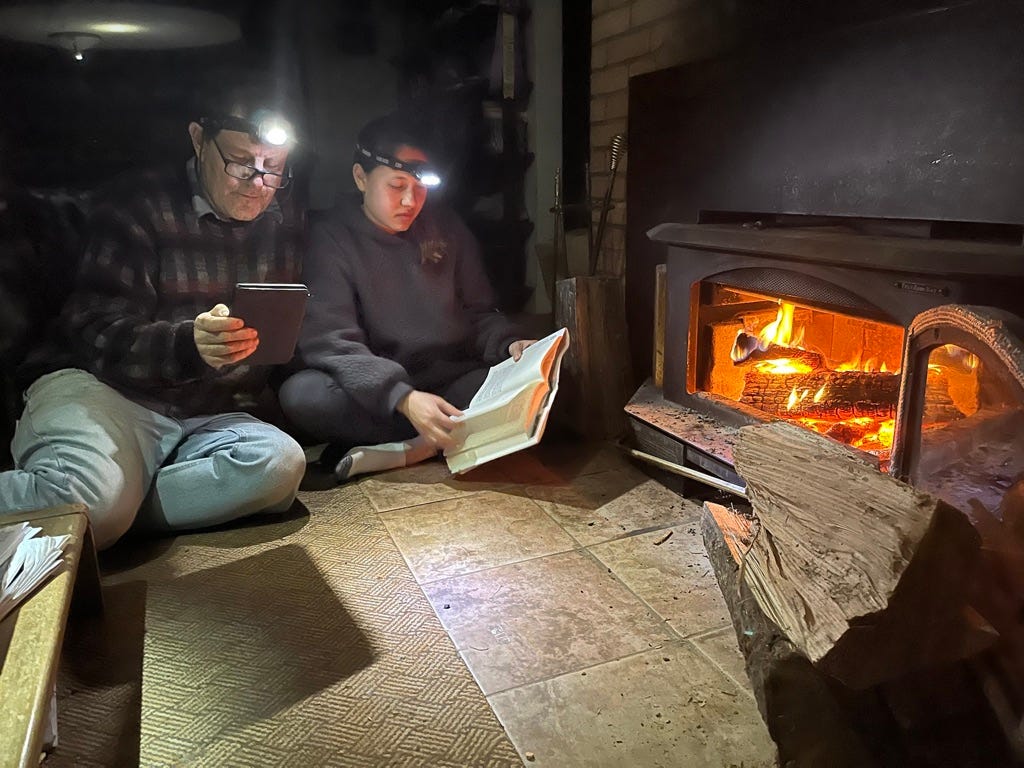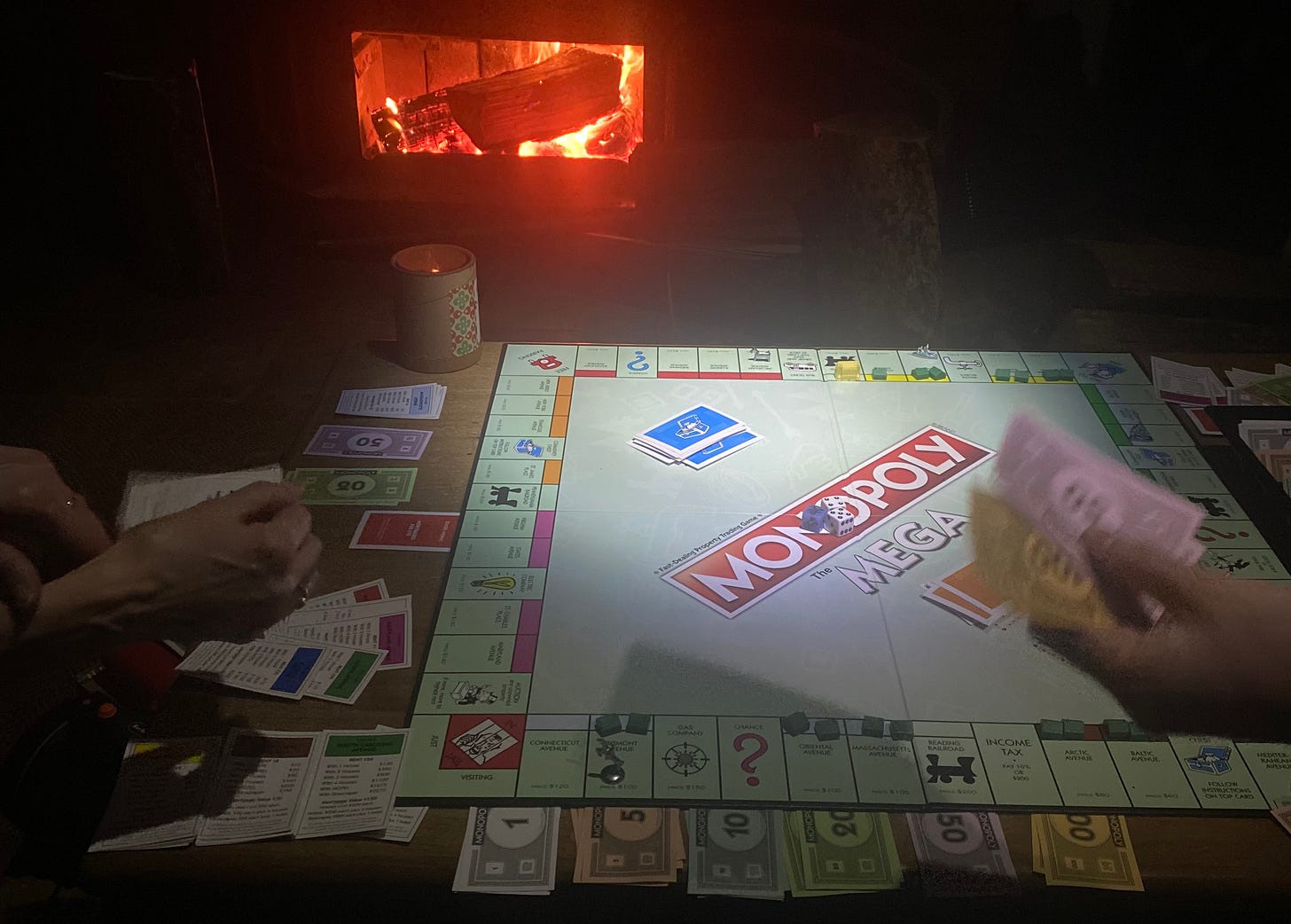When the Snow Falls...and the Power Goes Out
Shivering through my musings about the urban-rural divide and how to fix it
When the snow fell heavily at the end of December, our family farm became even more beautiful: Douglas fir trees laden with white are nature’s cathedral. But my awe for the beauty was tinged by apprehension for what I feared would come next. And it did.
Early in the morning a few days later, the lights went out. So did the heat. I walked down the driveway and, sure enough, about a quarter mile below our house a tree had fallen over from the weight of the snow, carrying the power lines with it. Worse, the tree and lines had fallen into a pond, making any repair more difficult.
I posted the outage on the website of PGE, our power company, and it reassuringly advised us that it expected power to be restored by midday. Sadly, that was not to be. The PGE repair trucks retreated when they saw the magnitude of the problem.
Prolonged power outages happen periodically, particularly in rural areas, and earlier this year our home lost power for about six days (the longest I can ever remember power ever going out on the farm). So we have a good supply of headlamps and a large stockpile of wood to keep the fireplace going, not to mention another critical tool to pass a winter evening when there’s no Internet, television or heat: board games. Two of our kids were visiting, so we spent the evening huddled around the fire together, reading, talking and playing games. As long as we were near the fire, at least one side of each of us was toasty.
Although we occasionally felt like popsicles with limbs, we all knew that those most affected by the winter cold are people who are homeless, particularly those without shelter and lacking electricity, heat and a fireplace. Here in Oregon, there are about 22,000 children who are homeless, and public policy has been singularly ineffective at dealing with the problem; we have the second highest rate of unsheltered homelessness in the country, and the shortage of housing units stands at 135,000 and is growing. Unless we get a handle on the supply imbalance, housing will become steadily less affordable and more people will lose shelter.
Another population disproportionately left to face the elements on their own are rural people, and not just in power outages, for rural families have been left behind in all kinds of ways. Americans often think of poverty as a problem of inner cities, but Save the Children says rural child poverty rates are higher than urban child poverty rates. Of the counties in the United States with child poverty rates above 50 percent, 93 percent are rural.
(We think of Save the Children as an aid organization active in Africa or South Asia, but it also does a fine job fighting poverty here in the United States. The poverty is in some respects different in the United States, but a common thread of those left behind whether in Zimbabwe or America is hopelessness and a lack of opportunity for children that creates generational cycles of disadvantage. Mark Shriver of Save the Children has been a powerful advocate on this issue, and if you’re looking for an aid group to support to fight child poverty in America, Save the Children is a great option.)
Depending on who does the math, the poorest county is sometimes said to be Holmes County in Mississippi (a rural county with a largely Black population) or Buffalo County in South Dakota (also rural, with a largely Native American population). Here in Oregon, the poorest county is Lake County, with a mostly white population in the south central part of the state.
There are rural areas without either cell phone service or broadband access, so how are children there supposed to engage in remote learning? More on that in a moment, but we have to do a better job bringing cell service and the Internet — and good jobs — to rural and urban communities alike, to knit them into the modern economy.
“I spent my whole life on the farm, and what did I get out of it?” Ron, a childhood friend, lamented to me once. “Debt. Meanwhile, my friends got jobs in the city and did fine for themselves. I wish that years ago I had given up the dream of keeping the farm and had done the same as them.”
Whenever the power goes out, I think with gratitude of President Franklin Roosevelt’s rural electrification, which from the 1930s through the 1950s brought power to so many farms around the country, transforming lives and opportunity. In Yamhill, some farms had set up little water wheels on streams to generate electricity to power a few lights — but most families didn’t have a stream nearby. Then the government strung power lines up, and the community was transformed.
If FDR hadn’t embraced rural electrification, I don’t know when power would have arrived, because it would have been enormously costly to connect farms far from the grid. Some families would have jury-rigged wires running from tree to tree, tied to limbs with baling wire, but this would have periodically caused fires. Rural America would be far less productive and far poorer without government programs that subsidized power.
Here’s the broader context. We as a country decided that there were certain things that everyone should have access to, such as electricity and postal delivery, police and fire protection, and at least some education. This ethos was marred by racial discrimination and inequity but it still contributed to a more equal and just America.
Yet that ethos seems to have faded. While we pretty much guarantee all Americans mail service, we don’t guarantee them health insurance, dental care, Internet access, shelter, child care, jobs or so much more. It’s not obvious why we deem free highways essential but not free pre-K. Some of the services mentioned above would be difficult or expensive to provide, but the same was true of universal postal service and electrical power.
Perhaps the most direct analogy with rural electrification is with President Biden’s proposals to bring high-speed Internet to areas that have been left behind, both rural and urban. Our own Internet service on the farm comes via a dish behind our house that is pointed at another dish seven miles away; if an owl perches on our dish, our connections waver. And this is a problem throughout rural Oregon. At last count, more than one-fifth of homes in Wheeler County, Sherman County, Harney County and similar rural counties lacked a broadband connection.
When communities lack this kind of infrastructure, the resulting frustration and sense of neglect magnify the distrust of government and proclivity for conspiracy theories and even violence. I worry when I hear some people talk venomously about taking up arms against the government. Healing the state and nation won’t be easy, but it has to involve greater efforts to build a business model for parts of the state and nation that have been left behind.
Biden’s infrastructure spending will help, and so will the arrival of the Starlink satellite Internet service (which we’re excited about here in Yamhill!). But I still think we should learn from rural electrification and invest more in communities left behind, both in urban neighborhoods and in rural America. And we should recognize that this isn’t charity or “spending” but an investment in a more productive and egalitarian future.
Look, in our case, the power came back the next afternoon — and enormous thanks to all repair crews out in weather like this. We were fine without power for a day and a half on the farm, especially with our kids around for the holidays. It was a novelty to huddle around the fire and play Monopoly by headlamp and firelight; it was fun to compete for the dogs that evening to warm our beds.
We’ve thawed and are (obviously) back online. But the episode underscored the importance of investing in creating opportunity for ALL of us, especially kids. We have to do a better job of that.
(I’m using these newsletters to touch on broader issues, not to press my present campaign for governor. So I’m not going to hit you here up for donations. But if you want to visit my campaign website, check out NickforOregon.com.)







Suggestion: It is complicated to have an electrician wire your power grid for a generator. You have to be able to switch from one to the other so that both can’t be on at the same time. In Alaska, either fires or storms can cause a power failure. We simple put an electric junction box outside the house, with line to a separate double plug inside. We simply put our generator outside, plug into the house, and then can plug in our heater, refrigerator and several lights. A simple Honda 2200w generator keeps us warm, protects our food, and gives light.
40 years ago, we lived in extremely rural West Virginia, in a mountain valley 30 miles from town, with heavy snow, rocky soil, and floods. The power never ever went out! Electricity was delivered throughout the remote valley by underground cable. It used no trees for wooden poles, started no forest fires, and did not require emergency crews in midwinter. Why can't we have that in Oregon? ... why isn't it required?